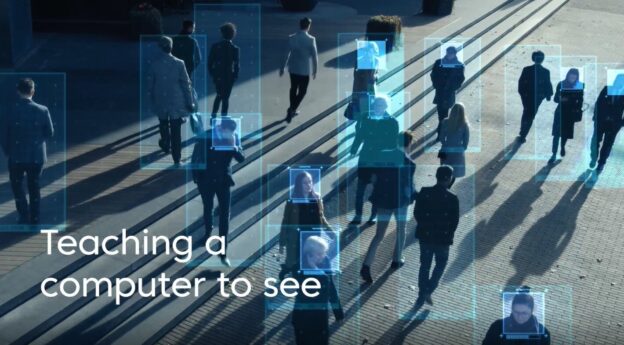By 2050, an estimated 4.1 million people will be affected by sight loss in the UK, making up a portion of the 14.1 million disabled people in the UK. How might digital twins create opportunities for better accessibility and navigability of the built environment for blind and partially sighted people? A new infographic presents a conception of how this might work in the future.
In their work with the Moorfields Eye Hospital in London, the Smart Hospitals of the Future research team have explored how user-focused services based on connected digital twins might work. Starting from a user perspective, the team have investigated ways in which digital technology can support better services, and their ideas for a more accessible, seamless experience are captured in a new infographic.
In the infographic, service user Suhani accesses assistive technology for blind people on her mobile phone to navigate her journey to an appointment at an eye hospital. On the way, she is aided by interoperable, live data from various digital twins that seamlessly respond to changing circumstances. The digital twins are undetectable to Suhani, but nevertheless they help her meet her goal of safely and comfortably getting to her appointment. They also help her doctors meet their goals of giving Suhani the best care possible. The doctors at the eye hospital are relying on a wider ecosystem of digital twins beyond their own building digital twin to make sure this happens, as Suhani’s successful journey to the hospital is vital to ensuring they can provide her with care.
Physical assets, such as buildings and transport networks, are not the only things represented in this hypothetical ecosystem of connected digital twins. A vital component pictured here are digital twins of patients based on their medical data, and the team brings up questions about the social acceptability and security of digital twins of people, particularly vulnerable people.
No community is a monolith, and disabled communities are no exception. The research team acknowledges that more research is needed with the user community of Moorfields to understand the variety of needs across the service pathway that digital twins could support. As such, developers need to consider the range of users with different abilities and work with those users to design a truly inclusive ecosystem of digital twins. The work by the Smart Hospitals research team raises wider questions about the role of digital technology both in creating more physical accessibility in the built environment but also potentially creating more barriers to digital accessibility. It is not enough to create assistive technologies if not everyone can – or wants to – have access to those technologies.
‘The role of digital technologies in exacerbating potentially digital inequalities is something that needs to be looked at from a policy perspective, both at the hospital level, but also more generally, from a government Department of Health perspective,’ says Dr Michael Barrett, the project’s principal investigator.
Dr Karl Prince, co-investigator, reflects that, ‘The traditional questions when it comes to this type of technology are raised as to: do they have access to equipment, and do they have the technical ability?’ The lesson is that you can build digital twins that create a better experience for people if you design digital systems from the perspective of an ecosystems of services, with input from users of that ecosystem.
Through exciting case studies, the project raises vital questions about digital ethics and the potentially transformative effects of digital twins on the physical built environment.
To read the infographic in detail, click here.
You can read more from the Smart Hospitals project by visiting their research profile page.
This research forms part of the Centre for Digital Built Britain’s (CDBB) work at the University of Cambridge. It was enabled by the Construction Innovation Hub, of which CDBB is a core partner, and funded by UK Research and Innovation (UKRI) through the Industrial Strategy Challenge Fund (ISCF).
To join the conversation with others who are on their own digital twin journeys, join the Digital Twin Hub.



Leave a comment